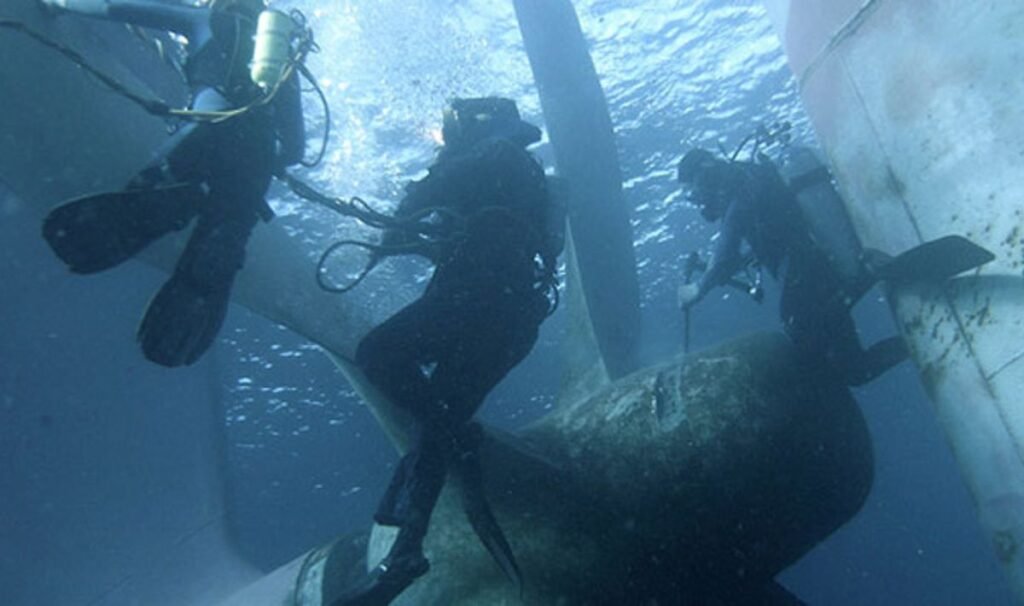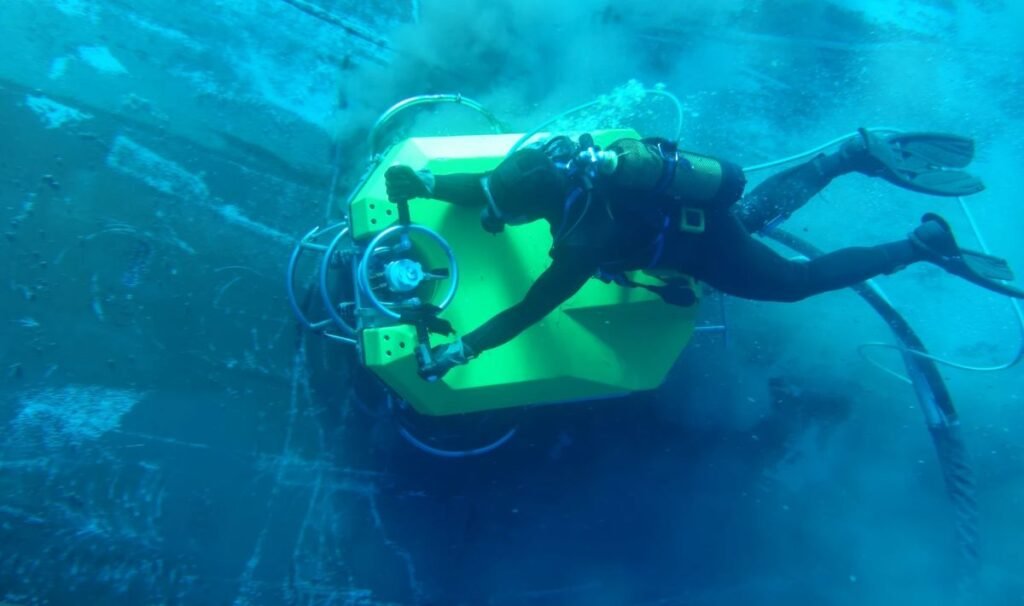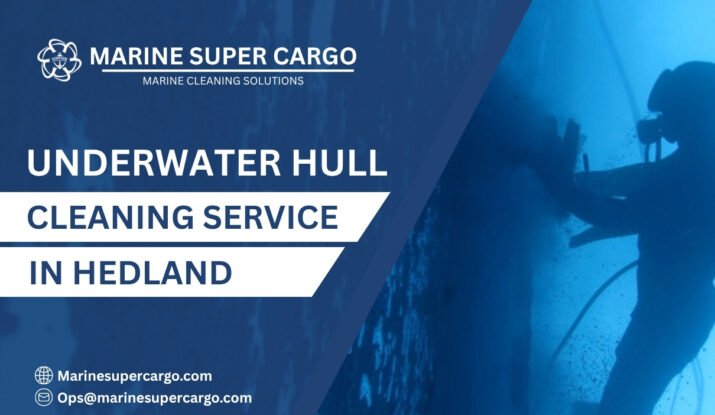Imagine your vessel gliding out of Port Hedland, slicing cleanly through the deep blue. But below the surface — hidden from the captain’s view — stubborn marine growth quietly weighs you down. In Hedland, one of Australia’s busiest ports, this isn’t just an inconvenience; it impacts everything from fuel costs to international biosecurity compliance.
That’s why underwater hull cleaning in Hedland is more essential than ever. Regular hull cleaning isn’t a luxury — it’s key to peak performance, cost efficiency, and a commitment to protecting both your investment and the irreplaceable Pilbara marine ecosystem.
Biofouling — The Invisible Enemy of Port Hedland
In Hedland’s warm waters, biofouling builds up fast, slashing speed, spiking fuel use, and disrupting shipping schedules. For bulk carriers, even a thin layer can cause costly delays. Worse, it spreads invasive species, posing serious biosecurity risks. That’s why Western Australian authorities push for modern, compliant in-water hull cleaning to protect marine ecosystems and keep fleets efficient.

How Often Should Vessels Be Cleaned in Underwater Hull Cleaning in Hedland?
Every vessel is different, but here’s the bottom line: if you operate in Port Hedland, you should expect to clean your hull every three months at a minimum. For vessels running continuous service or trading internationally, monthly inspections and touch-ups can make a massive difference in fuel savings and compliance.
Several factors influence cleaning frequency:
- Type of vessel: Large bulkers and tankers foul quickly.
- Antifoul state: Old coatings need supplemental cleanings.
- Pier/marina location: Stagnant water equals faster growth.
- Voyage patterns: The more time in tropical waters, the more cleaning you’ll need.
The takeaway? Set a program — and stick to it.
Methods of Underwater Hull Cleaning in Hedland
Underwater hull cleaning in Hedland has stepped into a new era, moving beyond simple hand scrubbing. Let’s look at the most effective methods:
Diver-Assisted Cleaning
Diver teams equipped with brushes, scrapers, and cameras deliver precision cleans for hulls, running gear, intakes, and even hard-to-reach spots. They provide reports, photos, and can spot signs of corrosion or damage. While tried and true, diver cleaning requires careful planning, safety oversight, and — in Hedland’s busy port — strict adherence to local regulations.
Robotic & Automated Solutions
Picture a high-tech underwater Roomba: robotic solutions, like those offered by Robotics and cling to your hull, dislodging fouling without damaging the paintwork or releasing debris into open water. These are perfect for both commercial fleets and sensitive environments, delivering faster cleans and tangible fuel/efficiency benefits.
The Rise of Enclosed Capture Technology
Hedland is at the forefront of eco-friendly in-water hull cleaning with its systems. These award-winning machines use blade and suction technology to clean and then completely capture and filter all removed biofouling. The result? Zero marine pollution, zero damage to antifoul coatings, and 100% compliance with environmental laws.
Choosing the Services of Underwater Hull Cleaning in Hedland
In Port Hedland, biosecurity and compliance are non-negotiable. When selecting a provider for underwater hull cleaning, look for:
- Proven compliance with IMO guidelines and local environmental laws
- Enclosed capture or eco-friendly robotic tech
- Full reporting: before/after photos, logs, and maintenance insights
- Experience with your vessel type—whether bulker, tug, tanker, or rig
- Certified safety standards and insurance (especially for diver teams)
- Operational flexibility to work during port stays or loading
A trusted provider helps you avoid delays, fines, and fouling-related breakdowns while keeping your vessel at peak performance.
What to Expect: Step-by-Step Cleaning Process
Curious about what happens during professional underwater hull cleaning in Hedland? Here’s the typical journey:
- Inspection: High-resolution cameras or sensors check fouling levels, antifouling wear, and any hull anomalies.
- Preparation: Set up for diver, robot cleaning, plus waste containment if needed.
- Cleaning: Targeted brushing, blade scraping, or water jetting removes biofouling—everything is captured and filtered.
- Post-Clean: Operators compile detailed reports with photos and recommendations for maintenance, compliance, and the next clean.
- Waste Handling: All biological material is treated or disposed of properly — nothing goes back into the port or bay.
The Major Benefits of Underwater Hull Cleaning in Hedland
Performance & Cost Savings
A clean hull moves through water like a dolphin, reducing drag and fuel costs by 10% or more. For commercial ships in Hedland, that’s a bottom-line gamechanger. It also means less engine strain, fewer mechanical surprises, and the ability to hit those tight port schedules.
Eco-Responsibility & Compliance
Choosing eco-friendly underwater hull cleaning in Hedland protects Pilbara’s unique marine habitats and keeps you on the right side of Australia’s strict environmental and biosecurity rules. Modern capture systems make it possible to clean without the risk of marine pollution or transporting pest species between continents.
Extending Vessel Life
Every patch of barnacle or algae is eating away at your investment. Regular underwater hull cleaning in Hedland stops corrosion, protects coatings, and lets you spot early warning signs of trouble, extending your ship’s useful life by years.
Safety, Regulations, and Environmental Standards
Port Hedland enforces some of Australia’s toughest hull cleaning rules. As per Ports Australia, only approved methods like enclosed capture or certified robotic systems are allowed. Divers must be licensed, all waste captured and treated, and detailed logs maintained. Always ensure your service provider is fully compliant before starting work.
Cost Factors: What Influences Prices Underwater Hull Cleaning in Hedland?
Prices depend on:
- Vessel size (bulk carriers and tankers cost more to clean than tugs).
- Level and type of biofouling.
- Chosen cleaning method — robotic/enclosed systems tend to be premium (but save fuel/allow cleaning during loading, which can offset higher upfront costs).
- Timing and urgency (rush jobs cost more).
- Frequency — a set program can mean savings thanks to less buildup to remove at each visit.
Smaller craft or routine cleans often cost just a few hundred dollars. But industry vessels should budget substantial amounts as a worthwhile investment in efficiency and compliance.

Preparation Tips: What to Do Before Your Next Clean
- Provide up-to-date antifoul and hull history.
- Clear decks, underwater sensors, and intakes of loose debris.
- Inform the cleaning provider of any areas needing special attention.
- Make sure all safety and port requirements are met, and coordinate with agents for smooth access.
The Future of Underwater Hull Cleaning in Hedland — Technology and Trends
Hedland is a testbed for global innovation in Underwater hull cleaning in Hedland
- Expect to see more robotic and driverless cleaning, allowing work even during cargo operations.
- Widespread adoption of enclosed capture systems will become standard for top-tier compliance.
- Enhanced data: cleaning services provide analytics on fouling, carbon savings, and predictive maintenance.
- Non-toxic, long-lasting antifouling paints mean fewer cleans, but proactive in-water maintenance is always needed for optimal performance.
Conclusion
A healthy, clean hull means lower costs, faster turnarounds, and staying ahead of Hedland’s strict environmental rules. By partnering with modern, responsible providers, you’ll enjoy greater efficiency, peace of mind, and the satisfaction of doing your bit for Australia’s coast. Underwater hull cleaning in Hedland isn’t just a task — it’s the secret to smooth sailing in one of the world’s busiest, most beautiful ports.


